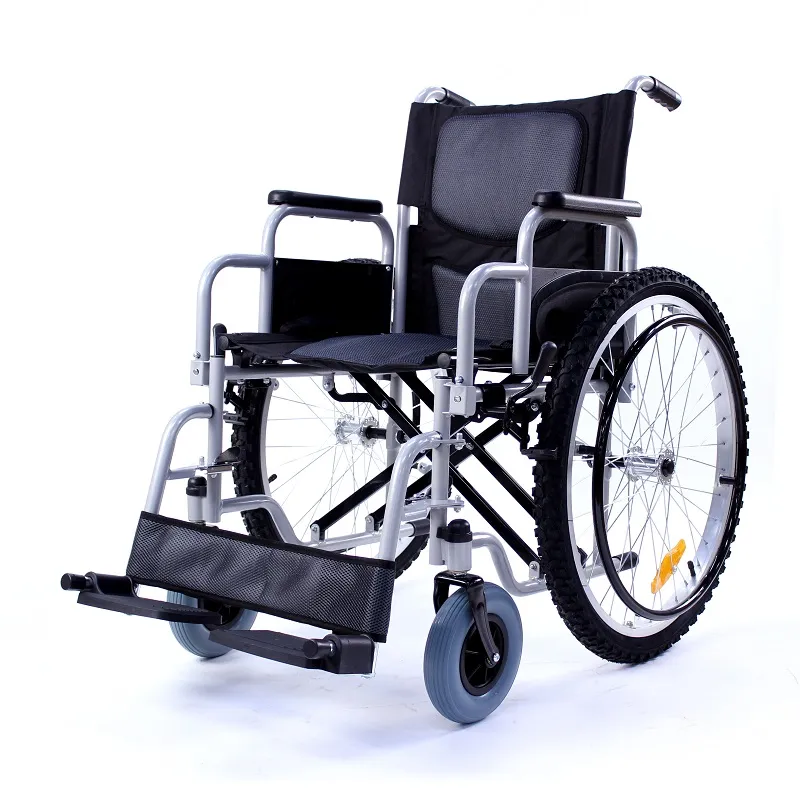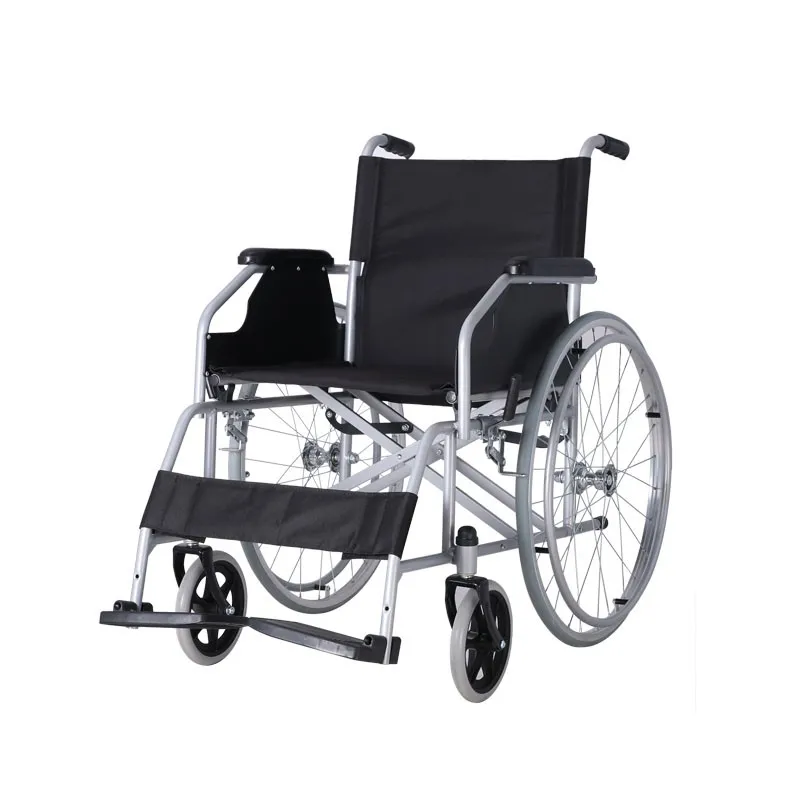In the field of rehabilitation equipment, manual wheelchairs are one of the most basic and widely used mobility aids. Whether in hospitals, nursing homes, or at-home long-term care settings, they are an indispensable "second pair of legs."
With technological advancements and the segmentation of needs, manual wheelchairs have been further refined into multiple categories. The two most popular types are heavy-duty manual wheelchairs and lightweight manual wheelchairs. These two categories each have their own unique characteristics in terms of material, structure, load capacity, and maneuverability.
However, precisely because of this wide range of choices, many patients, caregivers, and even primary care institutions face a core question:
"What are the advantages and disadvantages of manual wheelchairs? How do I choose between a heavy-duty and a lightweight?"
This report will systematically examine the real advantages and potential disadvantages of manual wheelchairs from multiple perspectives—structural design, ease of use, suitable population, price, and maintenance—to help users make informed choices and use them effectively.
What is a manual wheelchair?
A manual wheelchair is a non-motorized wheelchair that is moved by the user or a caregiver by pushing the wheel rims (handrails) or handles, without relying on electricity.
Its core components include:
· Small front wheels + large rear wheels;
· Seat cushion, backrest, and armrests;
· Push rims and brakes;
· Frame material (aluminum alloy, steel, titanium alloy, etc.);
· Possible accessories such as footrests, headrests, and side guards.
What are the main types of manual wheelchairs?
Main classification: Lightweight vs. Heavy-duty
Type | Features | Suitable For |
| Lightweight manual wheelchair | Lightweight (8–14 kg), easy to fold and carry, typically made of aluminum alloy or carbon fiber | High mobility, short-distance mobility, independent users |
| Heavy-duty manual wheelchair | High load capacity (supporting 150–250 kg), sturdier construction, typically made of steel, often used by heavier or bedridden users | Heavier users, severely restricted mobility, and those requiring caregiver assistance |
Lightweight manual wheelchairs: What are the advantages and disadvantages?
✅ Advantage 1: Lightweight, easy to carry and move
· Most lightweight manual wheelchairs are made of high-strength, lightweight materials such as aviation aluminum alloy and carbon fiber;
· One person can easily fold and fit in a car trunk, making them suitable for daily travel;
· Some models can even fold down to the size of a carry-on luggage compartment.
User experience: "I can fold my wheelchair into the back of my car without help, which gives me complete freedom." — Eva, a 30-year-old user with lower limb paralysis, reviews her carbon fiber lightweight wheelchair.
✅ Advantage 2: Easy to operate, saving effort and worry
· Lightweight wristbands and smooth control make them suitable for young users with frequent independent activities;
· High-end models feature ergonomic seat cushions and adjustable backrests, providing enhanced comfort for extended rides.
✅ Advantage 3: Easy to adapt to urban environments
· Lightweight wheelchairs are more easily adaptable to urban obstacles such as subways, elevators, and door frames;
· Small turning radius and increased maneuverability make them suitable for confined spaces such as restrooms and shopping mall aisles.
⚠️ Limitation 1: Limited load capacity
· Most lightweight manual wheelchairs are designed to carry loads between 100–120 kg;
· Possible safety risks for heavier users (over 130 kg);
· Some lightweight materials are not impact-resistant and may deform under impact.
⚠️ Limitation 2: Less structural stability than heavier models
· Lightweighting often sacrifices some frame rigidity and stability;
· Susceptible to roll or vibration on complex terrain (such as outdoor gravel roads and slopes);
· Not recommended for prolonged outdoor use or frequent uphill and downhill travel.
⚠️ Limitation 3: High Maintenance Cost
· High-quality materials (such as carbon fiber) are difficult and expensive to repair once damaged.
· Fragile components such as brakes, bearings, and tires wear quickly and require regular inspection.

Heavy-Duty Manual Wheelchairs: What are the Advantages and Disadvantages?
✅ Advantage 1: Superior Load-Bearing Capacity and Sturdy Structure
· For heavier users (150–250 kg), heavy-duty manual wheelchairs offer greater seat width and support.
· The frame is typically made of thick-walled steel to prevent deformation or breakage.
· Suitable for long-term home care, often driven by a caregiver.
✅ Advantage 2: Strong Stability and a High Sense of Security
· A wider chassis and lower center of gravity effectively prevent rollover and sideways tilt.
· Large wheels are suitable for unpaved surfaces such as grass and rural roads.
· Often equipped with accessories such as anti-roll wheels, anti-roll bars, and protective headrests.
✅ Advantage 3: Compatible with More Accessories and Medical Devices
· Easier to add accessories such as bedpans, oxygen cylinder holders, and IV poles;
· Some heavy-duty models are "semi-medical," suitable for use in hospitals or nursing facilities;
· Enables seamless transfer of patients from bed to wheelchair to toilet.
⚠️ Limitation 1: Heavy Weight, Difficult to Carry
· A heavy manual wheelchair typically weighs 18–28 kg or more;
· Difficult to fold and store, requiring two or more people to operate;
· Extremely inconvenient for climbing stairs and getting around, making it almost unsuitable for single people.
⚠️ Limitation 2: Poor Maneuverability, Unsuitable for Confined Spaces
· Large width and a long turning radius make it difficult to use in narrow corridors at home;
· Caregivers struggle to push it, especially in environments without ramps or with many obstacles.
⚠️ Limitation 3: Potentially Pressures Floors and Doorframes
· High load capacity and steel tires may cause indentations on home floors;
· Exercise extreme caution when moving over carpeted and wooden floors.

Manual Wheelchairs: Lightweight or Heavy?
Scenario | Recommended Types | Reasons |
| Users commuting/working/traveling | Lightweight Manual Wheelchair | Easy to carry and maneuver |
| Seniors using the device for daily short-distance travel | Lightweight Manual Wheelchair (Low Back) | Simple to operate and comfortable |
| Heavy-weight patients | Heavy-duty Manual Wheelchair | Safe and stable, not easily deformed |
| Rehabilitation centers/medical institutions | Heavy-duty Manual Wheelchair | Comprehensive compatibility and convenient care |
| Those frequently requiring a pushchair/stairs | Lightweight Manual Wheelchair (Foldable) | Highly efficient handling |
| Home care for those bedridden for extended periods | Heavy-duty Manual Wheelchair (Lifting) | Compatible with nursing beds and high-strength support |
Dayang Medical: How to Choose a Manual Wheelchair Scientifically?
"When choosing a manual wheelchair, consider not only weight but also the user's daily activity level."
—Wang Zhongming, Director of the Wheelchair Fitting Clinic at Beijing Rehabilitation Hospital
"Lightweight manual wheelchairs are suitable for users who prioritize freedom; heavy-duty manual wheelchairs emphasize safety and ease of care."
—Dr. Susan Field, Senior Engineer, Wheelchair Department, National Center for Rehabilitation Science and Technology, USA
"Don't just consider the quality of the material; you also need to pay attention to the "fit" between the wheelchair and the user's body proportions. Otherwise, advantages can become disadvantages."
—Gao Yuan, Wheelchair Evaluator, National Center for Assistive Devices

Manual Wheelchairs: Are They Good or Bad? Does "Fit" Matter?
Through this systematic analysis, we can see:
Manual wheelchairs aren't inherently good or bad; the key lies in the compatibility of usage scenarios, physical conditions, and care needs.
1. Lightweight manual wheelchairs offer advantages in flexibility, portability, and suitability for independent living.
2. Heavy-duty manual wheelchairs offer irreplaceable stability, high load-bearing capacity, and caregiving compatibility.
Therefore, before purchasing, we recommend that users undergo a professional evaluation and comprehensively consider their daily routine, weight range, upper limb function, and other factors to ensure both safety and efficiency.
In the wheelchair market, which is a battle between quality of life and choice, choosing the right wheelchair is more important than choosing the right one.
Can Dayang Medical provide walking aids and commodes?
Yes, besides wheelchairs and hospital beds, Dayang Medical supplies a full range of mobility and healthcare products, including walking aids, commodes, shower chairs, and canes. As a China-based factory manufacturer, we ensure high-quality production and affordable prices. Buyers can purchase wholesale quantities at low cost, benefiting from discounts and promotions for bulk purchases. Our sales team offers competitive quotes and customized solutions for international buyers.











